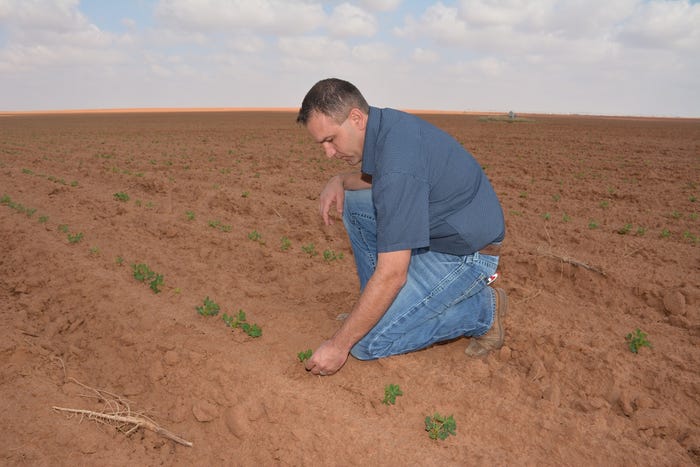
Jake Teichroeb checks peanuts as they push through the soil near Welch, Texas.
Since water is the most limiting factor for West Texas peanut farmers, Jake Teichroeb applies nutrients and other management resources based on the amount and quality of water available to specific fields.
Teichroeb, who farms near Welch, Texas, in Dawson County, but works fields spread over four counties, says knowing the potential and limitations of each field is crucial to efficient production, a daunting task with 3,000 acres in peanuts, 6,000 acres in cotton and about 1,000 acres devoted to forage and pasture for his black Angus cattle herd.
“Most of the water goes to peanuts,” Teichroeb says.
Rotation, fertility and timing (especially for weed control), are other key factors in producing an efficient peanut crop, he says.
He also contends that not trying to pull more out of the land than it’s capable of producing makes economic sense, considering the cost of inputs. “My father taught me how to farm, and he said it’s always better to let Mother Nature make the crop instead of buying the crop.” He says applying necessary nutrients, water and other material is important, but knowing the limitations of the field is equally so. “We add what it needs, but a lot of stuff we can buy is not necessary. Not every field will benefit from a higher fertility rate, so we have to know the fields.”
He says farming “one year at a time,” hampers efficiency. “I want to manage five years ahead,” he says.
That’s one reason he maintains acreage balance at 3,000 for peanuts and 6,000 for cotton. “That’s the way I have rotation set up—to be three years out of peanuts.”
Teichroeb’s commitment to efficiency helped him earn the 2017 Farm Press Peanut Efficiency Award for the Southwest region. Here are a few photos of Teichroeb’s operation.
About the Author(s)
You May Also Like






